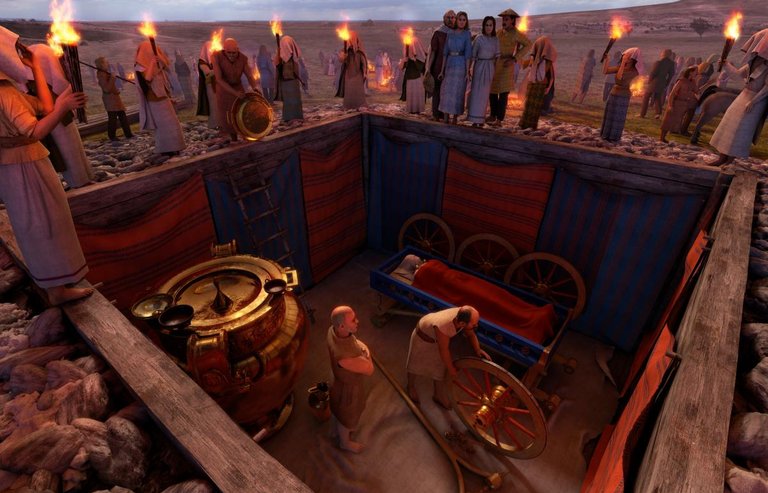
Until recently, the only Vix I knew about was the stock market’s Volatility Index (abbreviated VIX). If there were a volatility index for cryptocurrencies, I’d surely invest in it. And then there’s that cold medicine called Vicks. I caught a seasonal cold a couple of days ago, and my sinus headache felt like a hangover (though I didn’t drink) on New Year’s Eve. So I skipped the festivities and made an early night of it, waking up to 2018 when my dog needed to go outside in the early morning hours.

Vicks cold medicine.
It turns out there is another Vix, which I learned by viewing a documentary film last week about early Celtic burial sites in Europe. The Celts were somewhat mysterious, since their origins are not well known. Many people think of the Celts as largely having inhabited Ireland, Scotland, and Britain, where the language and cultural roots remained strong. But the early Celts were based much further south. Some historians even believe that those who reached the British Isles were a different people altogether.
Celtic grave sites from the 5th or 6th century indicate the culture was focused in modern day France, Germany, Switzerland, and Austria. These were the Hallstatt Celts, named for an extensive burial site located in Hallstatt, Austria, near the city of Salzburg. This site was located near a valuable salt mine and it dated back even earlier than many others. Over time, they spread to other regions of Western, Central, and Eastern Europe.
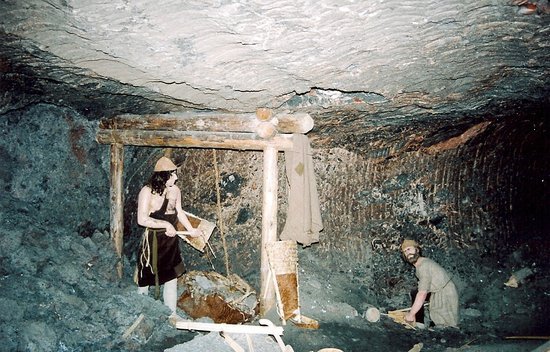
Hallstatt Salt Mine with depiction of early miners. Source link below.
Who Were the Original Celts?
Burial sites make it clear that the early Celtic culture had a strong Mediterranean orientation. Their most important people were buried with extensive riches, many of which were Greek or Italian in origin. It is not known whether they came from the Mediterranean region originally or simply traded heavily with the high cultures to the south. But the Greeks also provide the first written record of the Celts (which is important, since the Celts left no written records of their own).
The Greek historian Herodotus, who lived in the 5th century B.C., provided the first historical mention of the Celts. Herodotus was quite amazing himself, since he was the first Greek writer who ever mentioned anything beyond the Mediterranean region. He was known to have been born in the Persian Empire (in modern day Turkey) and he travelled extensively in the Mediterranean and Black Sea regions, chronicling many of the stories he heard.

The Greek historian Herodotus. Creative Commons via Wikimedia by Marie-Lan Nguyen.
Some were more believable than others, but many of his details have fit with other historical evidence. Like other writers of the time, Herodotus shared his historical chronicles by reading them in public. To great fanfare, he travelled to the Olympic Games and read his entire Histories to the crowd there.
Herodotus gave us the name Celts, which is used today. He described the people as living on the upper reaches of the Danube River. (He also said they dwelled beyond the “pillars of Hercules”, though that may have been one way to say they were not in the Mediterranean sphere. There were Celtic sites in Spain as well, beyond the Straits of Gibraltar that are generally believed to have been the pillars.)
If he traveled in the Black Sea region, then Herodotus may have seen the Danube River himself, since it empties into the sea there. He also would have come into contact with traders who voyaged further up the river. The Danube begins in the Black Forest in southern Germany and today it touches no less than 10 countries on its way to the Black Sea. From the Black Forest to the Black Sea, is one of the world’s longest rivers.

Map of the Hallstatt Celt culture. HistoryGuru.com.au.
An important Celtic site was unearthed at Heuneburg, in southern Germany, which sits near the banks of the upper Danube. It would have been a hugely important trading site and there is archaeological evidence that thousands of people may have lived at the Heuneberg citadel. The location on the upper Danube seems to be a perfect match for Herodotus’ account.
The Lady of Vix and Her Treasures
At early Celtic sites around Europe, very important people were buried with an impressive amount of their wealth. It is probably no accident that many such sites were located on major rivers, where the Celts would have been in a position to profit from these trade routes. This is certainly true of Vix, in northern Burgundy, France. Vix was the site of a large Celtic complex, centered on Mont Lassois, which could have controlled trade on the Seine River during its heyday in the 5th and 6th centuries B.C.
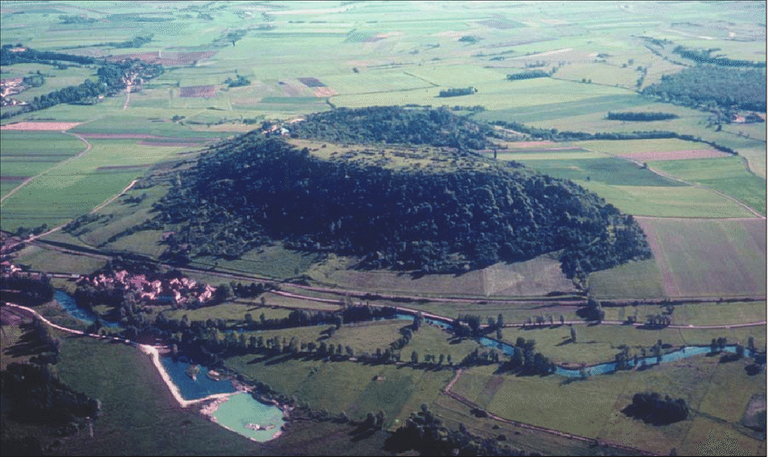
Mont Lassois, the flat hill topped by the Vix complex, set in a perfect position to control trade on the river. http://artehis.u-bourgogne.fr/.
A large palace building was excavated at the Vix site, its design resembling the architecture of early Greek halls. A big quantity of expensive and imported materials was found all over the complex, suggesting plenty of wealth and trade. In about 500 B.C., a woman of great importance was buried nearby.
The Lady of Vix has sometimes been called the Queen, Princess, or Priestess of Vix. Her identity is something of a mystery, but she was treated with extreme reverence. The Lady of Vix was buried with a chariot (cart) and a large amount of jewelry, including a 24-karat gold torc of 480 grams, a bronze torc, six fibulae, six slate bracelets, a bracelet of amber, and Etruscan rings. Nearby was a necklace of amber that probably belonged to her also.
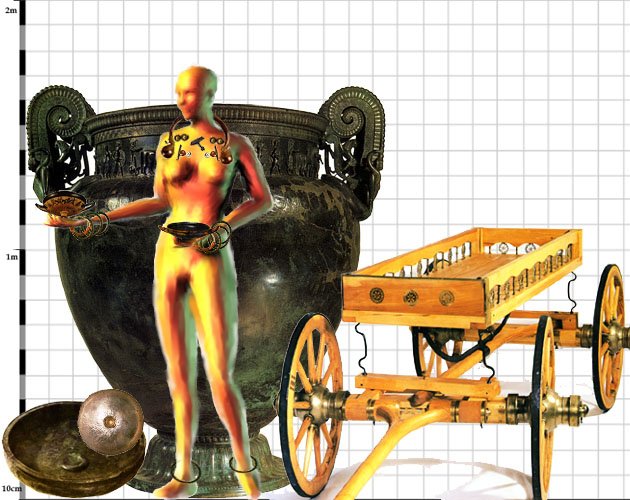
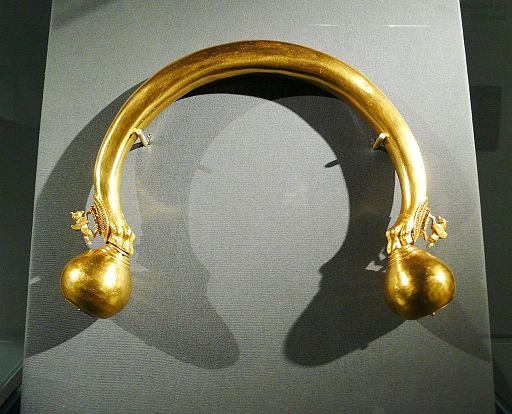
Lady of Vix and her possessions. Source: Realms-of-gold.com; Gold torque from Vix. Creative Commons via Flickr by Rosemania.
Her jewelry included items of both amber and coral. Amber, the fossilized tree resin which is highly prized, came from the Baltic region of northern Europe. The white coral in her jewelry would have come from the Mediterranean. These two items alone, found in modern-day Burgundy, are testament to a robust trading network at the time which must have stretched thorough Europe in almost every direction.
The Giant Krater
Herodotus also told of a giant bronze krater (a decorated pot often used for winemaking), made by the bronze smiths of Sparta and destined for a Lydian king (in modern day Turkey). He wrote that it was so big that it could hold 300 amphora of wine (about 300 gallons). But throughout history, there had never been any discovery that came close to this size. Historians laughed at the claim as a tall tale from Herodotus, since Greek kraters tended to be much smaller.
Then in 1953, a French archaeologist began scraping away mud from an object at the Vix grave that turned out to be a carved Gorgon with her tongue sticking out. It was a decoration on an immense Greek object, the likes of which no one had ever seen before. The object was a huge krater.
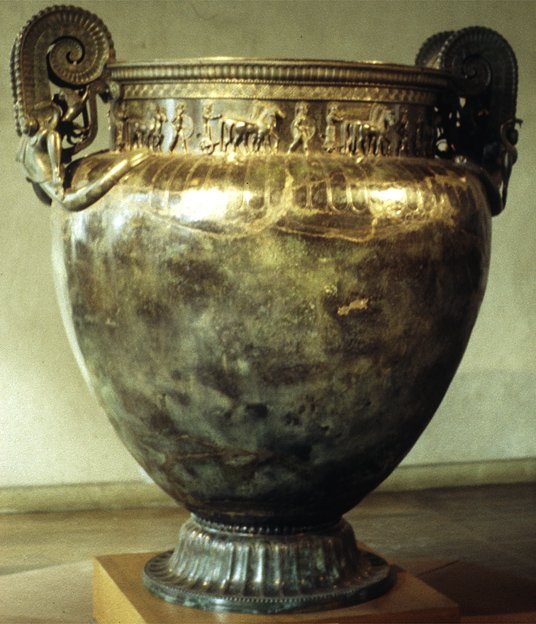

*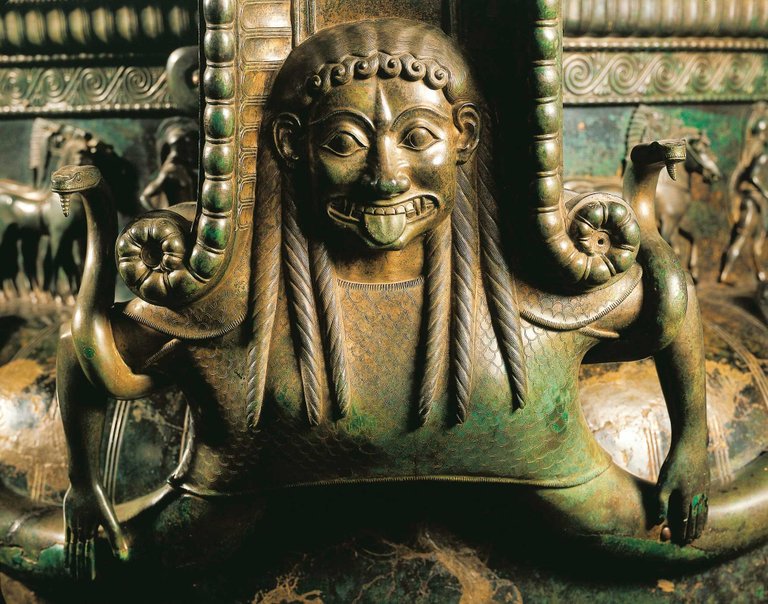
Krater of Vix and its detail work. Top: Creative Commons via Wikimedia by Peter Northover. Middle: Creative Commons via Wikimedia by Wikirigaou. Bottom: Nationalgeographic.com.
The bronze pot measured 5 feet 4 inches tall (1.63 meters) and weighed 450 pounds (200 kg). At 1100 liters, its capacity was almost exactly the 300 amphora (300 gallons) that Herodotus had described. This is the largest bronze vessel ever found from the western Classical period. And of all the possible kings and courts and rich merchants of the ancient world around the high culture of Greece, this krater was found thousands of miles/kilometers from the ‘known’ ancient world of the time.
It was buried in the tomb of the Lady of Vix.
Sources:
Enigma of the Celtic Tomb (video): https://www.amazon.com/Enigma-Celtic-Tomb-Alexis-Favitski/dp/B075H6RGV1
Herodotus: http://www.history.com/topics/ancient-history/herodotus
More on Herodotus: https://en.wikipedia.org/wiki/Herodotus
Heuneberg Celtic Site: https://en.wikipedia.org/wiki/Heuneburg
Vix Grave: https://en.wikipedia.org/wiki/Vix_Grave
The Huge Greek Krater at Vix: http://www.nytimes.com/1984/04/01/travel/a-greek-treasure-in-france.html?pagewanted=all
Musee du Chatillonais: https://www.burgundytoday.com/historic-places/museums/musee-du-chatillonnais.htm
Salt Mine Picture: https://www.tripadvisor.com/LocationPhotoDirectLink-g190427-d607563-i17172875-Salz_Welten-Hallstatt_Upper_Austria.html#17172875
Top image: www.geo.de
That was a very good read @donkeypong. Learned quite a bit about the Celts and Lady of Vix by reading your post.
It is common in most high cultures to bury their persons of status and renown with beautiful jewelry and other art pieces or weapons of war.
From the Pharaohs of old Egypt to the Scythian, Celtic burial mounds, most cultures shared similar burial customs.
That was a definitely harmonious admittance @donkeypong. Learned quite a bit roughly the Celts and Lady of Vix by reading your tallying.
It is common in most high cultures to bury their persons of status and renown when beautiful jewelry and accumulation art pieces or weapons of feat.
From the Pharaohs of dated-fashioned Egypt to the Scythian, Celtic burial mounds, most cultures shared same burial customs.
right man.
Haha, it my first glance, I think you are talking about the history of the vix index in stock market.
This is so interesting. I really would like to know the name of this mysterious "Lady of Vix" with so much wealth. But how come her name is not known? That wine cup is massive. The jewelries will pass for very expensive antiques.
Something that amazes me in history though, they seems to be in so much wealth then. Compare to now, do we still have such wealth, that could major for the wealth and riches in record of history back then?
We still do have such wealth but you have to look to the 1% for that. (or 0.01% more specifically)
The income disparity is really a serious issue.
So many questions and we may never know the answers.
First of all, get past your illness .. I'm sorry for you. I also learned about the celts that men understood that they were going to be prisoners and that when they killed their women, they belonged to the tribe. Whatever this is, my thoughts are reversed. I did not love them :)
Unique history and images. There is so much to learn around the world
Yes it is. He understands how to write good contents.
Karma may be a bitch, but Lady Vix is a Super Bitch!
I think, the meaning of the lady of vix statue biting her tongue, indicating she wanted to lock her secret.
interesting to review.
I'm at university for archaeology (paleolithic), and one of my TAs is a celtic archaeology P.HD student. She and I were just talking about this! Thanks for the great post--always love to see archaeology on Steem :)
Amazing. You probably know far more about it than I do! :)
I doubt that! My focus is in the overlap between modern humans, Denisovans, and Neanderthals, specifically in their fire and stone tool technologies and their varying propensities for creating material culture. I love Celtic archaeology, but the preservation of organic material in that part of the world is astoundingly bad because of the moisture, so a lot of the stuff I study never had a chance of surviving.
That's fascinating stuff. Perhaps you'll write more about it on your blog.
I'd love to! Unfortunately, most of my research is ongoing and still unpublished, so the stuff I'm directly involved in will need to wait. However, I could probably regurgitate some of my class papers on here. I have a recent one on the evolution of meat-eating in hominins...
A wonderful read. This brings up many questions both archaeological and historical in nature. I think of how much that Krater weighed. Like the pyramids of their day, I wonder if a Goliath or two were responsible for pacing this jewel there as it was over sized. It is intriguing to draw comparisons of these mystery cultures Celts, Egyptians, Mayans etc. How did these things happen. Normal humans are not that strong or able. I go back to another people - Goliath's, Fallen Angels, Hybrids of entities, Genesis 6, Enoch. Etc. Thanks for sharing.
Aren't the Celtics these guys with Kyrie Irving?
That the Hoops branch of Celts, circa 2018 A.D.
Hay donkeypong. My name is ubay. I have read your post. I think when we are dead. We do not need to bring our treasure to our cemetery. Better we give onother person who need money. But that is our past. So i think we dont need to do it again like that lady VIX. Thank you
It was a different belief system some of these cultures had. Today, most of us believe 'you can't take it with you' (your possessions).
Yea thank you donkeypong. btw nice posting. Now i can open my mind with thia different cultures.
@donkeypong - Wow. Looks like the Celtics followed similar traditions as the Egyptians with regards to burying their important personalities with their wordy treasures. Could there have been trade connections that account for such similarities?
Lady of Vix seems to be an important and intriguing character. In a male dominated society of that era, she must have wielded a huge influence to command such major burial honor. Will read up more on her.
The accuracy of the historian of that bygone era is amazing, considering that they had mostly word of mouth stories to rely upon. The giant Krater mentioned by Herodotus turned out to be accurate. It is interesting to find out how and why it ended in the Lady of Vix's burial chamber.
Thanks for this interesting article. Hope it sparks off lots of interest and some quests .. LOL. Upvoted full.
Regards,

@vm2904
Very interesting post. I wonder how valuable antiquities vanish from cultures and to find a piece so far away from what is thought to be the original location. It is just as though cultures just vanished only to appear a piece here and there with so seeming explanations. Thanks for sharing.
Someone had a very big metal pot to carry a long distance.
very good and interesting!!
I found your content very insightful.
The archeological image took a greater part of my time while I perused your post.
I look what you are doing.
"The Lady of Vix was buried with a chariot (cart) and a large amount of jewelry, including a 24-karat gold torc of 480 grams, a bronze torc, six fibulae, six slate bracelets, a bracelet of amber, and Etruscan rings. Nearby was a necklace of amber that probably belonged to her also."
What a waste of resources, that cannot happenin this modern age.
To be buried with such wealth is obscene. But they must really have been so wealthy. The lady of Vix, maybe was a queen and I heard that people were buried like that with the hope that they would need those valuables in their after life.
The krater is so massive and it's a wonder that they dug it up in one piece. A very interesting piece. Thank you for sharing and A very Happy and Prosperous New Year to you
Thank you for the insightful comment and Happy New Year to you also!
The mysterious lady of Vix was the answer to this question exactly what you gave us in a nice way. You explained to us through your post. It is difficult to understand me beautifully through your story, a beautiful story that really liked me, we love stories For them, this kind of story is very much like your knowledge experience Much praise is appreciated because you have done wonderful work like appreciating your knowledge experience which is what we all love most today's question is really amazing which can not be compared with anything that is wonderful, I shared your story with my friends, read the story to everyone I hope everyone feels good to me
I have read your most valuable post,really it is very interesting and historical post.I had never hear about The lady of Vix. Your photograph is historical.You also write about your felt a seasonal cold a couple of days ago, and your sinus headache felt like a hangover (though I didn’t drink) on New Year’s Eve.This is sad news,but I wish God always bless you.May be Lady of Vix was beautiful so The Lady of Vix has sometimes been called the Queen, Princess, or Priestess of Vix.I try to read your wonderful historical post.Its makes me much pleasure.Thanks to sharing this kind of educational and historical post.I am your follower and fan.I like your post.I wait for your next post.
There was this huge belief in life after death in those days, so they prepare the dead with lots of wealth to live with in the next life. I think that belief could be responsible for them burying people with so much valuables, and to survive centuries underneath the earth just shows how valuable they really are.
Happy New Year sir
@donkeypong, Thank you for the excellent post. You were nice explained about The mysterious lady of Vix. Its too interesting. I refer to read and search archaeological imagine and subjects lot. But I know lot more about my Sri Lanka history. Love to find Pre-Europe archaeological imagine. Your blog really helpful to me.
The Vix Krater turned out to be the centerpiece of a vast array of extraordinary objects that accompanied the burial of a mysterious woman. These jewelries too expensive and high worth indeed.
Vix has given a nice description about the mysterious lady, through which we have been fully aware of the vix that I love writing articles on your post thanks to you to discuss a good theory with us
Definitely greatest educative post you shared @donkeypong. Its interesting to find ancient topic. It has mysterious history. Vix is a nice conversation about mysterious woman. Those period language and cultural roots remained strong. Early Celtic culture had a extensive riches peoples. Buried with an impressive amount of their wealth at the Celtic places. Thanks you to the helpful me seek Mysterious lady of Vix.
Thanks for sharing. Same here, I only know what Vix is.
Why is Herodotus called “The Father of History”?
It’s between him and Thucydides who lived around the same time, they both approached history in a systematic and objective way using techiniques we take for granted today: first person sources, critical assessment of evidence etc.
I don't know much about him, but he must have been the first person to chronicle history that way in writing.
Very Important People Were Burried With Large Amount Of Their Wealth !!
#MNotImportantYet :PNow With Cryptos What Are They Gonna Do ?? Bury Me With My TREZOR ? 🤣🤣 🤣🤣
Haha. Give it away first. :)
Amazing story! :) I didn't know about any of that! Very cool to learn about the ancient trading routes and the possessions of value in the Celtic culture! Also that krater is absolutely massive! How could anyone possibly drink that much wine!? Crazy stuff!! I feel like it would go bad before people got a chance to drink it! Anyways I appreciate the post, and thanks for teaching me something cool! :)
So that's where my ex has hidden for years. Thanks for sharing this!
Just kidding. Haha! That Lady of Vix is really interesting and your research is awesome!!! Very informative, dude! :)
Hello @donkeypong , I am Annisa from Indonesia. Your article was great, but is it Vix almost same like Medusa? On her life story and faith maybe? I saw the sculpture and it is almost same
The decoration was a gorgon, a Greek figure that had some similarity to Medusa.
Oooh I see. Btw, follback please @donkeypong
The only "Vix" that I knew about was the Vicks medicine that you posted before I read through your write-up lol. I consider myself to know a decent amount of history but have never been well versed on anything Celtic, so this was a nice read!
Wow what a historical way to start the year. I personally though Celtic was an extension of the Scottish community thou thanks for this article and a happy new year to you
The Celts are much more closely identified with Scotland, Ireland, and other points in the greater British Isles, but they started in continental Europe.
Wow. Thanks for updating me bro
Indeed.
The Celts had made some minor inroads into the British Isles prior to the Norman Conquest (AD 1066) and its aftermath, but that was when they first settled there en masse, and from that point forward, there were waves of population exchanges going both ways.
And there were strong ties, particularly between Scotland and France, throughout the Middle Ages.
Anything related to archaeology and long forgotten mysteries of the past is my favourite thing!
Absolutely love to read about it and immerse in all this stuff.
Thanks, enjoyed it a lot, man!)
Whether we try to put our names on book spines, genes or jewelry in elaborate tombs, throughout time we all seek for immortality.
The celts really have a mysterious history that still has a lot to be uncovered
The location of Mont Lassois definitely makes it ideal for a trading capital for the river and i'd definitely love to know the full story of this mysterious lady of Vix
Interesting lesson and I didn't know a lot about the Celts, but this gives a little better of an understanding into at least some basic information about them, and also Vix.
But when you find out about treasure -
That's an awesome GIF!
A very interesting article and the whole history of the Celts is full of historical events and artifacts! Thank you Tom.
The Giant Krater (wine maker )is amazing piece of art...
Yes, it is. And it's amazingly well preserved.
vote steem82 sir
@donkeypong she was probably a princess,judging from the exquisite nature of the jewelry, it might be gifts from other princes or kings looking for an alliance between two kingdoms by marriage. Great article @donkeypong makes for an interesting reading. Compliments of the season.
I enjoy your history articles a lot. And the introduction to it was hilarious ( I hope you feel better now).
The ending was a bit abrupt, if there is a part two I'm very eager to read it.
Happy new year man!
Hi my dear friend.i read your post. I think when we are dead. We do not need to bring our treasure to our cemetery. Better we give onother person who need money.i follow you.
Thanks for the great post--always love to see
archaeology on Steem.@donkeypong
I really like this one Tom. I love reading every piece of information about mysterious historical events and ancient crafts related. But still can't get enough lol.
I was wondering deeply in the VICKS word. LOL
Then the letter VIX.. LOL... A Roman Numerals.
And VIX also is a graphical structure in real time. Oh man... A Headache to think about this... Hahaha... I like this historical event... Mysterious...
A very big fat brain you have to connect in one the word VICKS or VIX @donkeypong... I am really amazed...
Now you're breaking my brain. :)
You really make me smile! (^_^)
I read this blog 3x!! Hahaha... I like this mysterious... Then I research In google... LOL Very Good article! Hahaha...
Thanks for enlightening me that Vix could stand for more than the volatility index. :)
Don't know much about Celtic culture but I'm surprised to hear that they too following ancient Egyptian customs of burying the royalty or the important people of their time with personal treasures. I guess the similarity comes from the common belief of those times that people could somehow use material posessions into their after life too..
I'm always amazed by the celts, and the lady of Vix is a new addition to my body of knowledge regarding the complexity and dominance of their culture.
I'm expect that you're already a fan, but if not I am going to be so happy to introduce you to Dan Carlin's Hardcore History - specifically the most recent episode "Celtic Holocaust", about Ceaser's abject destruction of the once super powerful Celtic people. You'd love it.
I once had a girlfriend named Vix. She was a real fireball in the bedroom!

Amazing stuff 👌 thanks @donkeypong 👍for giving some mysterious details. Really exciting to know the mysterious lady Vix.... The treasure that were buried do indicates that vix was a queen of that era.
The krater with such a decoration is something very unusual at the burial site...
May be its burual or extinction of a civilisation...the curiosity to knw more keep me awake all night.
Thanks
@steemflow
That was a very good read @donkeypong. Learned quite a bit about the Celts and Lady of Vix by reading your post.
It is common in most high cultures to bury their persons of status and renown with beautiful jewelry and other art pieces or weapons of war.
From the Pharaohs of old Egypt to the Scythian, Celtic burial mounds, most cultures shared similar burial customs.
The interest in art and history is the life of civilized nobles and you are @donkeypong one of them
This is interesting one ! Truly informative on history !! The image are awesome !!
Until now, I didn't know about any of the "Vixes". But it's been very educative coming across this great write up.
Now I've added more knowledge to my historical background. Thanks for educating me on this, I'm really glad. And the Steem community has indeed surpassed my imaginations, never thought I'll be learning so much from this. Keep the good work going sir.